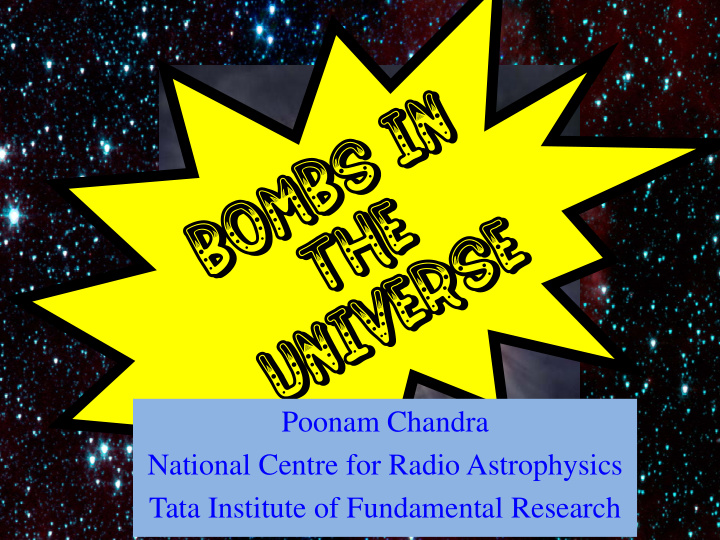



Poonam Chandra National Centre for Radio Astrophysics Tata Institute of Fundamental Research
SUPERNOVA EXPLOSION
Outline • What are Supernovae? • How we study them? • Why we study them? • What about us?
What are supernovae? DEATH OF A MASSIVE STAR
How big??? 100,000,000,000,000,00 0,000,000,000,000 (10 29 ) times more Single Supernova can energy than the energy shine brighter than As much energy as in an atmospheric 100,000,000,000 (10 11 ) sun will give in nuclear bomb!!!! stars. 10,000,000,000 (10 10 ) years.
In universe 8 new supernovae explode every second.
MILKY WAY
Universe has more than 125 billion galaxies 11 ‐ 09 ‐ 13 Poonam Chandra 8
Each galaxy has more than 100 billion stars 03 rd Aug 2007
10
DEATH OF A MASSIVE STAR
FATE OF SUN White Dwarf SUN
The Sun Luminosity=3.846×10 26 W Poonam Chandra 13
Nuclear fusion reactions 1 p + 1 p + 1 p + 1 p = 4 He
Chemical reactions inside every star More chemical reactions in heavy stars (10-50 Msun)
Nuclear reactions inside a heavy star
Gravitational Collapse Supernovae Poonam Chandra 19
Thermonuclear Supernovae
8M Θ ≤ M ≤ 30M Θ M ≥ 30M Θ Supernova Gamma Ray Burst Poonam Chandra 23
Gamma Ray Burst
What are Gamma Ray bursts (GRBs)? Most energetic events in the universe Poonam Chandra
We detect roughly one GRB per day.
How we study them? 21 st Dec 2006
radio
GRB Missions BeppoSAX BATSE Poonam Chandra 30
31 Poonam Chandra AGILE FERMI 11 ‐ 09 ‐ 13
32 Poonam Chandra SWIFT
X-ray telescopes 33 XMM XMM Poonam Chandra
Atacama Large Millimeter Array Poonam Chandra 34
VLA RADIO TELESCOPES GMRT
Why we study them? Supernovae: the seeds of life
BIG BANG 75% HYDROGEN 25% HELIUM HEAVY ELEMENTS???? 03 rd Aug 2007
Nuclear reactions inside a heavy star
Supernovae: seeds of life Calcium in our bones Oxygen we breathe Iron, Aluminium in our cars 11 ‐ 09 ‐ 13 Poonam Chandra 40
Supernova and our Universe Everything going away from us? 03 rd Aug 2007
What about us? • We? • Our Earth? • Our Solar System? • Our Galaxy?
SN 1006 � Discovered by China, Japan, Europe, Arab in May , 1006. � Visible for 3 years till 1009. � Very bright Supernova in Lupus constellation. 21 st Dec 2006
� Observed by chinese on May 1, 1054. � Bright enough to cast shadow on earth. � Brighter than ¼ moon. 21 st Dec 2006 � In Taurus Constellation.
Tycho � Observed by Europeans and east Asians on early November, 1572. � In constellation Cassiopeia. � As bright as Venus.
Kepler � Discovered by Europeans and Chinese on Oct 9, 1604. � Visible on earth for 1 year. � 3 degrees NW of Mars ‐ Jupiter conjunction.
CAS A � Observed by Flamsteed? � Exploded in 1658? 21 st Dec 2006
Ill Effects? � Biological damage if too close. Mass extinction of dinosaures due to SN? � DNA damage due to high-energy particles (neutrinos) � Radiation damage to atmosphere Destruction of ozone layer Which gives us UltraViolet protection. 21 st Dec 2006
How Close is Too Close? 30 light years Nearest star is 4 light years 21 st Dec 2006
Nearest Supernova Candidate BETELGEUSE 500 light years away Our Earth is Safe…
THANKS 21 st Dec 2006
NASA • http://science.nasa.gov/researchers/education- public-outreach/
Energy scales in various explosions ~10 ‐ 6 MeV/atom Chemical explosives Nuclear explosives ~ 1MeV/nucleon Novae explosions ~few MeV/nucleon Thermonuclear explosions ~few MeV/nucleon ~ 15 (B/10 15 G) Mev/electron SGR giant flares Core collapse supernovae ~100 MeV/nucleon 11 ‐ 09 ‐ 13 Poonam Chandra 53
ASCA Swift ROSAT XMM Chandra Poonam Chandra 54
Poonam Chandra
Recommend
More recommend